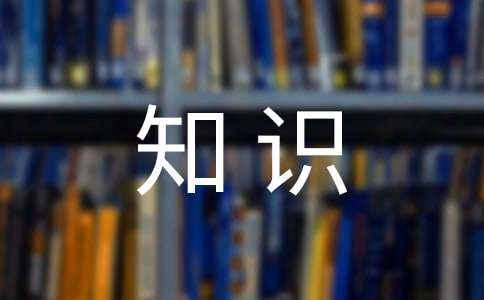高一英语必修一知识点总结5篇
总结是事后对某一阶段的学习、工作或其完成情况加以回顾和分析的一种书面材料,它可以促使我们思考,让我们来为自己写一份总结吧。总结你想好怎么写了吗?下面是小编收集整理的高一英语必修一知识点总结,欢迎大家分享。

高一英语必修一知识点总结1
1、 especially, specially
especially adv. 特殊地;尤其是
(1)侧重于多种事物或人中比较突出的。I like all the subjects at school, especially English. (尤其是英语)
(2) especially 后可接介词短语或从句。I like the Yuelu Mountains, especially in spring. (尤其是在春天) Noise is unpleasant, especially when you are trying to sleep.
specially 侧重特意地、专门地做某事 (后面常接for sb. 或to do sth.)
I made a chocolate cake specially for you.
2、 boring, bored, bore
boring adj. 令人厌烦的 The book is very boring.
bored adj. 感到厌烦的 I'm bored with the book.
bore vt. 令人厌烦 This book bores me.
有些表示情感的及物动词,有与bore类似的用法。如:interest, excite, surprise, amaze, frighten, astonish, move, inspire, touch, scare, disappoint, puzzle, worry 这类词的现在分词形式,为“令人……”;过去分词形式,为“感到……”。
3、 except for, except, but, besides
表示“除了”的词或短语有:except; but; except for; besides; except that (when.。.) 等。
(1) except 和 but 都表示“除了……之外。没有”,二者大多数情况下可以互换;但在no, all, nobody, nothing, no one 等词后多用 but。No one knows our teacher's address except / but him. (排除him)
(2) besides 除……之外,还……,有附加性。What other foreign languages do you know besides English? (English与other languages都属于know的范围)
(3) except for 只不过……,整体肯定,部分修正,用于排除非同类事物,for表示细节上的修正。 Your article is well written except for a few spelling mistakes.
4、 know, know of, know about
(1) know 用作动词,意思是“(直接地)获知,懂得,认识,熟悉”。I don't know whether he is here or not. / I know him to be honest.
(2) know of和know about的意思都是“(间接地)获知”,指听别人说到或从书报上看到,二者没有什么区别。
5、 for example; such as
(1) for example“例如”,用来举例说明某一论点或情况。一般只举同类人或物中的“一个”为例,作插入语,可位于句首、句中或句末。可用for instance替换。For example, air is invisible. / His spelling is terrible! Look at this word, for example.
(2) such as “例如”,用来列举事物,一般列举同类人或事物中的几个例子。插在被列举的事物与前面的名词之间,as后面不可有逗号。Some of the European Languages come from Latin, such as French, Italian and Spanish.
[注意]如把前面所述情况全部举出,用that is或namely。
高一英语必修一知识点总结2
一、一般过去将来时
1、概念:立足于过去某一时刻,从过去看将来,常用于宾语从句中。
2、时间状语:The next day (morning, year…),the following month(week…),etc.
3、基本结构:主语+was/were +going to + do+其它;主语+would/should + do+其它
4、否定形式:主语+was/were+not + going to + do; 主语+would/should + not + do.
5、一般疑问句:was或were放于句首;would/should 提到句首。
6、例句:He said he would go to Beijing the next day.他说他第二天要去北京。
I asked who was going there.我问,谁要去那里。
二、 现在进行时
1、概念:表示现阶段或说话时正在进行的动作及行为。
2、时间状语:Now, at this time, days, etc. look. listen
3、 baihuawen.cn 基本结构:主语+be +doing +其它
4、否定形式:主语+be +not +doing+其它
5、一般疑问句:把be动词放于句首。
6、例句:How are you feeling today?你今天感觉如何?
He is doing well in his lessons.在课上他表现得很好。
高一英语必修一知识点总结3
as 可作关系代词,引导定语从句。
1.as
as可以在限制性定语从句和非限制性定语从句中作主语或宾语。
① 在限制性定语从句中,as可跟在由suc, so, the same修饰的'先行词之后。
Such men as heard him were deeply moved. 听过他说话的人,都会深受感动。(as在定语从句中作heard的主语)
I've never heard such stories as he tells. 我从未听过像他讲的这样的故事。(as在定语从句中作tell的宾语)
He lifted so heavy a stone as no one else can lift. 他搬起别人都搬不起的大石头。(as在定语从句中lift的宾语)
比较:
在the same
高一英语必修一知识点总结4
各种时态的被动语态
被动语态概述
被动语态的概念:它是动词的一种形式,表示主语与谓语之间的执行或被执行关系。主动语态表示主语是谓语动作的执行者,例如:They saw the little boy crying by the river. 被动语态表示主语是谓语动作的承受者,例如:The little boy was seen crying by the river.
被动语态的构成
被动语态的形式是由“助动词be+动词的过去分词”构成。助动词be随着主语的人称、数、时态等的不同而变化。几种常见时态的被动语态形式如下:
1、 一般现在时 am/is/are + 过去分词
例如:Rice is planted in the south of China.
2、 一般过去时 was/were + 过去分词
例如:These trees were planted the year before last.
3、 一般将来时 will/shall + be + 过去分词
例如:A sports meeting will be held next week in our school.
4、 现在进行时 am/is/are + being + 过去分词
例如:Your radio is being repaired now.
5、 过去进行时 was/were + being + 过去分词
When he got there, the problem was being discussed.
6、 现在完成时 have/has + been + 过去分词
His work has been finished.
Has his work been finished? Yes, it has. / No, it hasn’t.
7、 过去完成时 had + been + 过去分词
注意:
1、除了be之外的其它系动词如get, stay等也可以和过去分词构成被动语态。例如:Their questions haven’t got answered.
2、 含有情态动词的谓语变成被动语态使用“情态动词+ be + 过去分词”结构。例如:
More attention should be paid to the old in this country.
This work can’t be done until Mr. Black comes.
3、 含有“be going to”, “be to”等结构的谓语,其被动语态分别用“be going to + be + 过去分词”和“be to + be + 过去分词”。例如:
The problem is going to be discussed at the next meeting.
All these books are to be taken to the library.
4、 被动语态与系表结构的区别:“连系动词+用作表语的过去分词”构成的系表结构,与被动语态的形式完全一样,所以应注意它们的区别。被动语态中的过去分词是动词,多强调动作;系表结构中的过去分词相当于形容词,多强调状态。前者通常可用by 引出动作的执行者,而后者则不可以。例如:
The map was changed by someone.(被动结构)
That custom remained unchanged for many centuries.(系表结构)
系表结构中的过去分词通常可被very修饰,被动语态中的过去分词往往要用much修饰。
例如:
He was very excited.(系表结构)
He was much excited by her words.(被动结构)
5、 主动形式表被动意义。有些动词的主动形式有被动意味,如 open, read, sell, shut, wash, wear, write等。此时句子的主语一般是物。例如:
These books sell well. 这些书很畅销。
The door won’t shut. 这门关不上。
The clothes wash well. 这些衣服很好洗。
高一英语必修一知识点总结5
重点单词
major local represent curious introduce
approach stranger express action general
avoid misunderstand similar agreement adult
punish intend means universal cultural
apologize behave bow flight defence
dormitory canteen dash comfortable distance
prefer touch custom false hug
function international powerful greet fist
yawn threaten respectful association gesture
【高一英语必修一知识点总结】相关文章:
高一英语必修一知识点总结12-21
高一英语必修1知识点总结10-08
高一英语知识点总结必修108-03
英语高一必修1知识点总结01-27
外研社高一英语必修一知识点总结09-27
人教版高一英语必修一知识点总结08-03
人教版高一英语必修三知识点总结09-22
高一英语必修1知识点难点总结10-08
高一英语重要必修1知识点总结10-19
高一英语必修一知识点汇总笔记05-09
